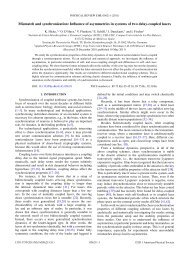DBI Analysis of Open String Bound States on Non-compact D-branes
DBI Analysis of Open String Bound States on Non-compact D-branes
DBI Analysis of Open String Bound States on Non-compact D-branes
You also want an ePaper? Increase the reach of your titles
YUMPU automatically turns print PDFs into web optimized ePapers that Google loves.
CHAPTER 5. BRANES 61c<strong>on</strong>diti<strong>on</strong>s can end <strong>on</strong> them; i.e. that the endpoints <str<strong>on</strong>g>of</str<strong>on</strong>g> an open string satifsying Dirichletboundary c<strong>on</strong>diti<strong>on</strong>s are located <strong>on</strong> a D-brane. 1What makes D-<strong>branes</strong> so extremely interesting is that they provide a way to introducegauge symmetries in string theory, which in turn hints at a possible way to createstandard model-like models from a stringy perspective.The easiest way to motivate the necessity for D-<strong>branes</strong> is by c<strong>on</strong>sidering T-duality.Hence, this secti<strong>on</strong> will start with a short expositi<strong>on</strong> <str<strong>on</strong>g>of</str<strong>on</strong>g> this subject. Then we will have alook at the influence <str<strong>on</strong>g>of</str<strong>on</strong>g> the gauge fields generated by the closed strings in the two TypeII superstring theories <strong>on</strong> the possible D-<strong>branes</strong> in these theories. We will c<strong>on</strong>clude byhighlighting a possible low-energy acti<strong>on</strong> that describes the world volume <str<strong>on</strong>g>of</str<strong>on</strong>g> a D-brane.5.1.1 T-dualityTo make our lives easier, we will again go back for a sec<strong>on</strong>d to the bos<strong>on</strong>ic string theoryand its corresp<strong>on</strong>ding 26-dimensi<strong>on</strong>al space-time. We will investigate what happenswhen we <strong>compact</strong>ify <strong>on</strong>e spatial dimensi<strong>on</strong>. Compactifying in essence comes down totaking a dimensi<strong>on</strong>, and identifying (at least) two points in this dimensi<strong>on</strong> with eachother. A natural way <str<strong>on</strong>g>of</str<strong>on</strong>g> doing so, is to c<strong>on</strong>sider this dimensi<strong>on</strong> to be curled up into acircle.We will start by c<strong>on</strong>sidering what happens to closed strings, and then have a lookat what changes for the case <str<strong>on</strong>g>of</str<strong>on</strong>g> open strings.Closed stringsThe first thing to do, is simply to choose <strong>on</strong>e <str<strong>on</strong>g>of</str<strong>on</strong>g> the 25 spatial dimensi<strong>on</strong>s to <strong>compact</strong>ify.We will not try to be original, but instead choose to do as everybody else, and hencechoose the 25 th dimensi<strong>on</strong>. As such, <strong>compact</strong>ifying this dimensi<strong>on</strong> amounts to statingthat this dimensi<strong>on</strong> satisfies the topology <str<strong>on</strong>g>of</str<strong>on</strong>g> a circle with some arbitrary (but fixed, <str<strong>on</strong>g>of</str<strong>on</strong>g>course) radius R. Now, a closed string with a comp<strong>on</strong>ent that lives in this dimensi<strong>on</strong>obviously has to go around the entire circle at least <strong>on</strong>ce. But nothing forbids it <str<strong>on</strong>g>of</str<strong>on</strong>g>winding around it multiple times. Just think <str<strong>on</strong>g>of</str<strong>on</strong>g> an elastic that you wind around acurled up poster or something: you can wrap it around just <strong>on</strong>ce, but nothing forbidsyou from making a figure-<str<strong>on</strong>g>of</str<strong>on</strong>g>-eight with your elastic and hence wrapping it around twice.Because <str<strong>on</strong>g>of</str<strong>on</strong>g> this newly acquired freedom, our original closed string boundary c<strong>on</strong>diti<strong>on</strong>,Eq. 2.16, gets modified with an extra term as follows:X 25 (σ + π, τ) = X 25 (σ, τ) + 2πRW. (5.1)Herein, W ∈is called the winding number, and expresses how many times the stringwinds around the circular dimensi<strong>on</strong>. The directi<strong>on</strong> in which the string is winded isencoded in the sign <str<strong>on</strong>g>of</str<strong>on</strong>g> W. This extra term is explained by the simple observati<strong>on</strong> 2that the closed string boundary c<strong>on</strong>diti<strong>on</strong> relates <strong>on</strong>e and the same point <strong>on</strong> our string,1 This immediatly implies that a string and a D1-brane are two separate things.2 The simpler an observati<strong>on</strong>, the l<strong>on</strong>ger it usually takes to figure it out.
















